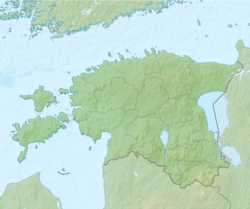This article has multiple issues. Please help improve it or discuss these issues on the talk page. (Learn how and when to remove these messages)
|
Viljandi | |
|---|---|
Clockwise from top: Viljandi town hall; Old water tower; downtown; Ugala theatre; University of Tartu Viljandi Culture Academy, St. John's church; Sakala Centre | |
Location within Baltic Sea region | |
| Coordinates: 58°22′N 25°36′E / 58.367°N 25.600°E | |
| Country | |
| County | |
| Founded | 1283 |
| Government | |
| • Mayor | Madis Timpson |
| Area | |
| • Total | 14.62 km2 (5.64 sq mi) |
| Elevation | 83 m (272 ft) |
| Population (2019) | |
| • Total | 17,407[1] |
| • Rank | 6th |
| Ethnicity | |
| • Estonians | 94% |
| • Russians | 3% |
| • other | 2.1% |
| Time zone | UTC+2 (EET) |
| • Summer (DST) | UTC+3 (EEST) |
| Postal code | 71020 |
| ISO 3166 code | EE-897 |
| Website | www.viljandi.ee |
Viljandi (Estonian pronunciation: [ˈvilʲːjɑnʲːdi], German: Fellin, Latvian: Vīlande, Polish: Felin, Swedish: Fellin) is a town and municipality in southern Estonia with a population of 17,407 in 2019.[1] It is the capital of Viljandi County and is geographically located between two major Estonian cities, Pärnu and Tartu. The town was first mentioned in 1283, upon being granted its town charter by Wilhelm von Endorpe. The town became a member of the Hanseatic League at the beginning of the 14th century, and is one of five Estonian towns and cities in the league. The once influential Estonian newspaper Sakala was founded in Viljandi in 1878.
- ^ a b "Statistikaamet". Retrieved 10 October 2019.











